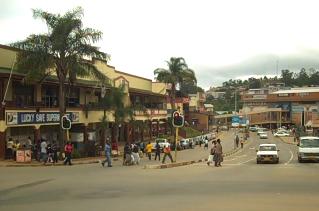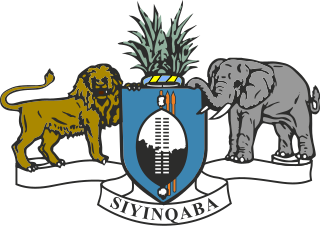
Artifacts indicating human activity dating back to the early Stone Age have been found in the Kingdom of Eswatini. Prehistoric rock art paintings date from c. 25,000 B.C. and continuing up to the 19th century can be found in various places around the country.

Mbabane is the capital and largest city in Eswatini. With an estimated population of 94,874 (2010), it is located on the Mbabane River and its tributary the Polinjane River in the Mdzimba Mountains. It is located in the Hhohho Region, of which it is also the capital. The average elevation of the city is 1243 meters. It lies on the MR3 road.

Mswati III is the King of Eswatini and head of the Swazi Royal Family. He was born in Manzini, Eswatini, to King Sobhuza II and one of his younger wives, Ntfombi Tfwala. He was Tfwala’s only child. He attended primary school at Masundvwini Primary School and secondary school at Lozitha Palace School. From 1983 to 1986, he attended Sherborne School in north-west Dorset, England. He was crowned as Mswati III, Ingwenyama and King of Swaziland, on 25 April 1986 at the age of 18, thus becoming the youngest ruling monarch in the world at that time. Together with his mother, Ntfombi Tfwala, now Queen Mother (Ndlovukati), he rules the country as an absolute monarch. Mswati III is known for his practice of polygamy and currently has 15 wives. Although he is respected and fairly popular in Eswatini, his policies and lavish lifestyle have led to local protests and international criticism.

Hhohho is a region of Eswatini, located in the north western part of Eswatini from the north and running southwards to the centre, Hhohho was named after the capital of King Mswati II, who expanded the Swazi territory to the north and west, taking in the districts of Barberton, Nelspruit, Carolina and Piet Retief. These areas were later acquired by what was the Province of Transvaal and today they form part of the Mpumalanga Province of South Africa. It has an area of 3,625.17 km², a population of 320,651 (2017), and is divided into 14 tinkhundla. The administrative center is the national capital of Mbabane. It borders Lubombo Region on the southeast and Manzini Region in the southwest.

The Swazi or Swati are a Bantu ethnic group of Southern Africa, predominantly inhabiting modern Eswatini and South Africa's Mpumalanga province. The Swati are part of the Nguni family that can be archaeologically traced in East Africa where the same tradition, beliefs and cultural practices are found. The Swati share a unique experience, culture and Royal lineage. This lineage is exclusive to the inhabitants of Eswatini, even though there have been more Swazi people that have moved to South Africa and the United Kingdom in the 20th century. The original inhabitants of Eswatini no longer reside in Eswatini as a majority population while some remain in the land. The Swazi people and the Kingdom of Eswatini today are named after Mswati II, who became king in 1839 after the death of his father King Sobhuza who strategically defeated the British who occupied Swaziland. The Kingdom of Swaziland was a region occupied by the San people of Southern Africa and the current Swazis came in from North Eastern regions through to Mozambique and eventually Swaziland in the 15th century. Mixtures with the San people and other Nguni tribes occurred. Their royal lineage can be traced to a chief named Dlamini I; this is still the royal clan name. About three-quarters of the clan groups are Nguni; the remainder are Sotho, Tsonga, others North East African and San descendants. These groups have intermarried freely. There are slight differences among Swazis as a nation with varying features and skin tones yet Swazi identity extends to all those with allegiance to the twin monarchs Ingwenyama "the Lion" and Indlovukati "the She-Elephant". The dominant Swati language and culture are factors that unify Swazis as a nation since there is no other language spoken except for English.

Manzini is a city in Eswatini, which is also the capital of Eswatini's Manzini Region. The city is the country's second largest urban centre behind Mbabane, with a population of 78,000 (2008). It is known as "The Hub" of Eswatini and lies on the MR3 road. Eswatini's primary industrial site at Matsapha lies near the town's western border.

The House of Dlamini is the royal house of the Kingdom of Eswatini. Mswati III, as king and Ngwenyama of Swaziland, is the current head of the house of Dlamini. Swazi kings up to the present day are referred to as Ingwenyama and they rule together with the Queen Mother who is called Indlovukati. The Swazi kings, like other Nguni nations, practice polygamy and thus have many wives and children.

The Royal Swazi Sun Hotel is a major entertainment complex in the Ezulwini Valley of Eswatini. Founded in 1965, the complex is located 4 hours from Johannesburg by road. It is home to a casino, a par-72 golf course, and a spa. The hotel features 149 rooms and is known for its luxurious accommodation. Business Insights called the Royal Swazi Sun Hotel the flagship of Sun International's four hotels in the area.

The following outline is provided as an overview of and topical guide to Eswatini:

Hlane Royal National Park is a national park in Eswatini, roughly 67 km northeast of Manzini along the MR3 road. Prior to the park being public, it was a private royal hunting ground. Hlane, meaning 'wilderness', was named by King Sobhuza II. It is now held in trust for the Nation by His Majesty King Mswati III, and is managed by Big Game Parks, a privately owned body.
Mlilwane Wildlife Sanctuary is Eswatini's oldest protected area, owned and managed by a non-profit trust.
Prostitution in Eswatini is illegal, the anti-prostitution laws dating back to 1889, when the country Eswatini was a protectorate of South Africa. Law enforcement is inconsistent, particularly near industrial sites and military bases. Police tend to turn a blind eye to prostitution in clubs. There are periodic clamp-downs by the police.
Mdimba is a mountain and hill range in northwestern Eswatini. Mount Mdimba flanks the eastern side of the Ezulwini Valley. This valley was once the residence of the Swazi royal family and is shrouded in legends and mysteries. The Mdimba hills historically have had strategical importance and contain many caves in which locals would hide during raids. In 1826, the Swazi people retreated into the hills during an attack by the Zulus. The Boers met with the locals of Mdimba on 16 December 1889.
Ezulwini Handicrafts Centre is a handicrafts centre of notable regional significance located in the Ezulwini Valley in northwestern Eswatini, off the MR3 road. The centre was opened following investment by Taiwanese entrepreneurs and features many locally made sculptures, jewelry, textiles and other crafts.
Ndvungunye was King of Swaziland from 1780 until his death in 1815 after succeeding his father, King Ngwane III following a very brief regency of Indlovukati LaYaka Ndvwandvwe. Very little has been recorded of the quality of leadership under his reign. Ndvungunye built his residence or Sigodlo near Mhlosheni on feet of the eMhlosheni hills in NShiselweni, the south east of modern Swaziland near Zombodze, where his father Ngwane had settled during his reign. His rule thus indicated a period of limited expansion and consolidation which is overshadowed by that of his son King Sobhuza I. The NShiselweni settlements established under his reign which he placed under the guardianship of his chief Sukumbili Mbokane would not however provide a solid foundation for the future Swazi state as indicated by attacks after his death on Sobhuza by Ndvwandvwe chiefs. Ndvungunye died around 1815 after being struck by lightning. Ndvungunye was married to Lojiba Simelane and Somnjalose Simelane. It was with the latter that he had his son Sobhuza I. Lojiba however became Queen mother as she was a senior sister to Somnjalose. Sobhuza I became the king in 1815 after the regency of Queen Lomvula Mndzebele.
SwaziBank, is a development finance institution, which doubles as a commercial bank in Eswatini. It is licensed and supervised by the Central Bank of Eswatini, the national banking regulator. As of March 2018 SwaziBank was the only indigenous commercial bank in the county, with the other three having their headquarters in neighboring South Africa.










